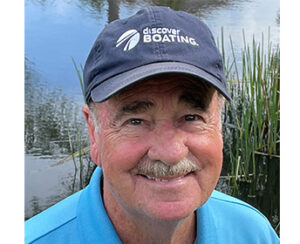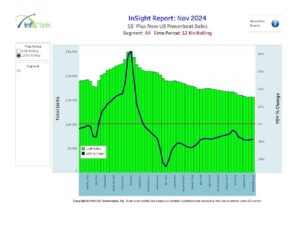While 50 years ago a burning Cuyahoga River ignited a actions for serious water protection policies (see Dealer Outlook, Tuesday, June 18), today a proposal to construct wind turbines in fragile Lake Erie without conducting a full Environmental Impact Statement (AIS) is drawing a growing outcry from a variety of organizations and individuals.
Among the leaders in this fight is the Lake Erie Marine Trades Association (LEMTA). Earlier this week, a letter to the editor by LEMTA’S president, Michelle Burke, was published in Crain’s Cleveland Business. It clearly identifies a full AIS is needed to determine any impact on this lake that supplies 12 million people with drinking water and is among the nation’s great natural resources. Here is the letter:
Environmental Impact Statement Needed for Icebreaker
It’s becoming rough sledding for “Icebreaker,” the proposed wind turbine farm in Lake Erie off Cleveland by the Lake Erie Energy Development Corporation (LEEDCo), as more groups are calling for a full Environmental Impact Statement (EIS) to be undertaken before final construction permits are issued.
LEEDCo’s application is now before the Ohio Power Siting Board. It has already received thumbs up from several federal, state and local agencies. But new information now coming to light has business, sportsmen and environmental groups saying these agencies, including the Ohio Department of Natural Resources and the U.S. Fish & Wildlife Service, among others, have failed in their responsibility to demand an EIS before any permits can be given.
An EIS, under U.S. environmental law, is required by the National Environmental Policy Act (NEPA) for any actions “significantly affecting the quality of the human environment.” An EIS is a tool for decision making. It describes the positive and negative environmental effects of a proposed action and it can also list alternative actions to those proposed.
The purpose of the NEPA is to promote informed decision-making by regulatory agencies by making “detailed information concerning significant environmental impacts” available to both agency leaders and the public. The NEPA was actually the first piece of legislation that created a comprehensive method to assess potential and existing environmental risks at once.
LEEDCo has submitted an Environmental Assessment (EA), which is a smaller, shorter document created by its paid consultant to justify the wind farm in the lake. And, not all proposals require a full EIS. If the proposed action will not cause a significant impact the smaller, shorter EA document can be acceptable. In other words, if the EA indicates no significant impact is likely, then there can be a “Finding of No Significant Impact” (FONSI) and the project can move forward. Most EAs result in a FONSI.
However, such a conclusion in Icebreaker’s case simply doesn’t stand up to scrutiny. Indeed, as far back as a year ago, even the OPSB staff found more than 35 potential problems with it and suggested any approval of LEEDCo’s application must contain a myriad of conditions. But in recommending conditions the staff was just looking the other way regarding the needed full EIS which LEEDCo does not want to undertake.
There are many reasons for demanding the EIS that LEEDCo trying to prevent. Icebreaker is being touted a “just a six turbine demonstration project” off Cleveland’s shores. But the truth is it’s intended to trigger construction of 1,400 or more turbines in the lake. LEEDCo’s recent response on Cleveland’s public radio by its vice president of operations referring to an EIS: “If more are going to be built, an EIS could be done then.” Sure, that will make it somebody else’s problem. But, just the prospect that hundreds of spinning turbines could blight our lake demands a full EIS now, before Icebreaker.
Further, LEEDCo’s plan to build turbines in the source of drinking water for millions of Cleveland area residents cannot be taken lightly. It is a fact, for example, that dredged materials from the Cuyahoga River containing carcinogens — including PCB’s, dioxin, mercury, cadmium, lead and arsenic — have been annually dumped in the lake off Cleveland for more than 100 years. That accumulation rests on the lake bottom. Clearly the detailed analysis in an EIS of any effects on our drinking water supply during turbine construction and the laying/maintenance of miles of transmission cables back to shore is the minimum needed to protect the public. But there’s more.
Wind turbines often explode. The Icebreaker turbines will each contain more than 400 gallons of lubricating oils and fluids. The prospect of gear boxes throwing flaming blades and hundreds of gallons of oil into our drinking water supply would be a direct violation of the nation’s Clean Water Act. Oh, but there’s more.
It’s believed “Icebreaker” will violate the U.S. Endangered Species Act as well as the Migratory Bird Treaty because Lake Erie is a nationally recognized flyway, according to the National Audubon Society, American Bird Conservancy and the Black Swamp Bird Observatory. Spinning 300-foot turbine blades are certain to slaughter countless birds and bats. What does swimming in bird carcasses floating into Edgewater Beach do for you?
To avoid this, LEEDCo has proposed a one-year radar monitoring program for modeling patterns of migration and bird slaughter. But the truth is there’s currently no radar or monitoring system in the world that can detect an endangered species, or even non endangered species. So, LEEDCo has also suggested it could shut down the turbines during peak bird migration periods. However, turbines don’t produce power when they’re not spinning. And, wind being generally unpredictable is why rate payers can expect to pay 550 percent more for the power from Icebreaker when it is turning than the same power available from the grid.
Lake Erie was once called a “dead lake.” But it’s now our source of good drinking water, a thriving fishery, home to countless waterfowl including the comeback of bald Eagles along our shoreline, and a magnet for millions of dollars in tourist money spent in Ohio each year. Still, the lake is a fragile ecosystem and the call for a full EIS to determine the true impact of turbines in it should be the right action for the OPSB.
For even more insight, go to: www.saveourbeautifullake.org










